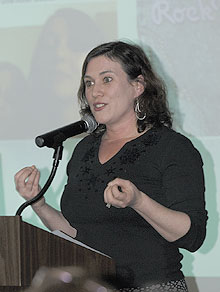  |
| HOME | THIS ISSUE | CALENDAR | GRANTS | BACK ISSUES | < BACK | NEXT > |
Socializing via Internet natural for today’s teens, says speaker by Gregory Hladky - April 21, 2008 | ||||
| If teachers and parents don’t know what Soulja Boy is or why carmakers are sponsoring virtual-world Internet sites for 13-year-olds, Anastasia Goodstein thinks it’s time they learned. Goodstein, author of Totally Wired – What Teens and Tweens Are Really Doing Online, believes adults need to start experiencing for themselves how young people are connecting and interacting in this Internet age. “You should all be on a ‘social network,’” Goodstein told an audience April 11, during the sixth annual Northeast Media Literacy Conference at the Bishop Center, “New Media Literacies for Today’s Plugged-In Generation.” The event was sponsored by UConn’s Neag School of Education, the national Action Coalition for Media Education, and the Alliance for a Media Literate America, and coordinated by Thomas Goodkind, professor of curriculum and instruction in the Neag School of Education. Goodstein, one of two keynote speakers at the conference, is the founder and editor of Ypulse.com, an Oakland, Calif.-based daily blog providing news and comment about “Generation Y” for the media and marketing industry. She said she decided to write a book about young people and the Internet after a media and government frenzy erupted several years ago over sexual predators using social networking sites such as MySpace. “I was beginning to see another wave of social panic,” Goodstein said. She said similar adult “anxiety attacks” have happened whenever youngsters started to embrace a new information technology, whether it was comic books or television. “I wanted to write a book I felt would be really balanced,” said Goodstein, who believes that government efforts to curb or block social networking sites for teens are misguided and uninformed. Today’s teenagers aren’t fundamentally different from the teens of 30 or 40 years ago, Goodstein said. “What it feels like to be a teenager hasn’t changed,” but the way teens and pre-teens interact with the world has been revolutionized. She said the motivation is the same: “It’s that age-old desire to stay connected – but amplified.” Instead of hanging out at the mall or spending hours talking to friends on an old-fashioned “land line” telephone like their parents did, Goodstein said today’s “wired teen” hangs out online or text-messaging friends at 3 a.m. She said MySpace was originally a social networking site for musicians, and teens initially gravitated to it in order to connect with their favorite bands.
Even though the site was public and open to everyone, teens began to feel that it was a space essentially for teenagers. But the furor over Internet sexual predators resulted in what teens felt was an invasion by parents and police. “Suddenly, their space wasn’t their space anymore,” she said. In the past year, according to Goodstein, the majority of MySpace profiles have become private and there has been “an exodus over to Facebook,” a networking site originally focused on college students. She said that well-meaning efforts to block teen use of school and library computers for social networking could end up discriminating against low-income teens who have no home computers. Instead of blocking social networking sites for teens, Goodstein said, educators, counselors, and parents need to become more actively involved in learning about such technology and teaching young people how to use it responsibly. Understanding the power of the Internet is a good beginning. Soulja Boy was at the start nothing more than a homemade video by a Memphis teenager posted on YouTube. It is now an international phenomenon that has produced a dance craze and triggered an outburst of creative video parodies and variations. Goodstein warned that advertisers and marketers are seeking to manipulate teen and pre-teen consumers in extraordinary ways. The makers of the Scion car, she said, now sponsor a virtual-world site for pre-teens, to try and imprint that vehicle as something desirable for the consumers of the future. Goodstein said teachers and parents need to ask young people how they are spending their time online, ask their help to solve computer problems, and start teaching teenagers and pre-teens about the marketing strategies that are being used to manipulate them. |
| ADVANCE HOME UCONN HOME |

